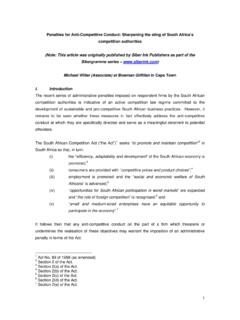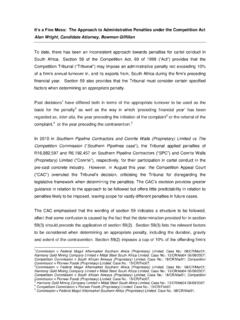Transcription of Fly America Act and Open Skies Agreements Fly America Act
1 Fly America Act and Open Skies Agreements Fly America Act Generally, when one is travelling on funds provided by the federal government they must use Flag Carriers. Such carriers include American, United, Delta, US Airways, etc. This requirement must be observed even in instances where foreign carriers are cheaper, provide preferred routing, more convenient, or part of a frequent flyer agreement such as Star Alliance. There are limited exceptions contained in the act. Travel to and from the Use of a non carrier is permissible if: The airport abroad is the origin or destination airport, and use of a carrier would extend the total travel time 24 hours or more than would travel by non carrier; or The airport abroad is an interchange point, and use of a Carrier would require the traveler to wait four (4) hours or more to make an overseas connection or would extend the total travel time six (6) hours or more than would travel by non carrier.
2 Travel between points outside the Use of a non carrier is permissible if: Travel by non carrier would eliminate two (2) or more aircraft changes en route; or Travel by carrier would extend the total travel time six (6) hours or more than would travel by non carrier. Short Distance Travel. For all short distance travel, regardless of origin and destination, use of a non carrier is permissible if the elapsed travel time on a scheduled flight from origin to destination airport by non carrier is three (3) hours or less and service by carrier would double the travel time.
3 Further exceptions in the Code of Federal Regulations include: When the air carrier only has seats in first and/or business class, and economy class service is available from a non air carrier. When non air carrier service is deemed a matter of necessity per the following: When the agency determines that use of a non air carrier is necessary for medical reasons, including use of non air carrier service to reduce the number of connections and possible delays in the transportation of persons in need of medical treatment; or When use of a non air carrier is required to avoid an unreasonable risk to your safety and is approved by your agency ( terrorist threats).
4 Written approval of the use of non air carrier service based on an unreasonable risk to your safety must be approved by your agency on a case by case basis. An agency determination and approval of use of a non air carrier based on a threat against a flag air carrier must be supported by a travel advisory notice issued by the Federal Aviation Administration and the Department of State. An agency determination and approval of use of a non air carrier based on a threat against Government employees or other travelers must be supported by evidence of the threat(s) that form the basis of the determination and approval; or When you cannot purchase a ticket in your authorized class of service on a flag air carrier, and a seat is available in your authorized class of service on a non air carrier.
5 Open Skies Agreements Recent international treaties referred to as Open Skies Agreements also provide a limited exception to the Fly America Act. Where an open Skies agreement exists a traveler may use the foreign airline except when a GSA City Pair exists, or the travel is funded by the Department of Defense. Open Skies Agreements exist with: European Union ( ). Australia Switzerland Information on GSA City Pairs may be found at: If transportation is between points for which there is a city pair contract fare in effect, contractors and grantees traveling on US Government funds are still required to use flag air carrier service unless one of the other exceptions to the use of such service, as set out in the Federal Travel Regulation, applies.
6 Procedure If one is using a non Carrier for federal government funded travel, it is important that the following steps are observed: 1. Documentation is retained supporting the specific exception claimed. This includes: a. Travel site data indicating the absence of US based carriers b. The specific amount of time that use of a Carrier would require c. Any safety information such as State Department travel advisories that recommend that Carriers not be used d. Documentation, from a licensed practitioner, of any medical condition that requires use of a foreign carrier, and for what reason ( shorter elapsed time, wider seats, etc.)
7 E. Screen print of GSA site showing absence of a City Pair if the Open Skies exemption is claimed. Reminders Consider what is an appropriate interchange point, or gateway city, when a foreign airline must be used. Generally an interchange point will not be in the United States ( not JFK, EWR, LAX), but will likely be the capital, or large city, near the destination. Examples of improper gateway cities found recently: Baltimore was indicated as the gateway city for flying to Oslo, Norway, and the traveler flew on SAS, a non Carrier.
8 However, Oslo is served by several carriers from New York airports. This flight was not eligible for federal grant reimbursement. New York was indicated as the interchange point for a flight to Johannesburg, south Africa, with a plane change there for Lusaka, Zambia. However, several Carriers serve Johannesburg, which should have been used. This flight was not eligible for federal grant reimbursement. Lower cost is not an acceptable criteria for exception. Code Sharing, a process by which a ticket may be issued by one airline but flown by another, requires that the ticketing airline be the Carrier.
9 The carrier is defined by the airline designator noted on the ticket. Examples: American flight 4332, shown as AA 4332 on the ticket, flown by British Airways, is considered a Carrier. Japan Airways 324, shown on the ticket as JL 324, flown by American Airlines, is not considered a Carrier. American flight 467, shown on the ticket as AA467, that happens to be the same plane as JL 324 above, is a Carrier. Frequent flyer Agreements such as Star Alliance do not infer Carrier status on their members absent the utilization of a Code Shared flight with a designator.









